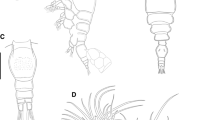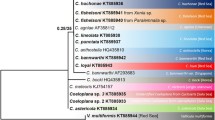Abstract
Pectinids constitute one of the most conspicuous groups of marine bivalves, and include some of the most important species from the point of view of fisheries and aquaculture. In spite of this, their systematics and evolution are not well understood. Only two molecular phylogenetic analyses based on relatively wide taxonomic samplings have been published. These studies largely neglected American species, some of which are central for testing current models of pectinid evolution and diversification, or are commercially valuable. We have sequenced 820 nucleotide base pairs of the 12S and 16S ribosomal RNA genes in nine species of pectinids belonging to six genera living along American coasts. Sequences from homologous regions of 19 other species were gathered from public databases. We constructed phylogenetic maximum-parsimony and maximum-likelihood trees of this set of 28 taxa. Our phylogenetic analysis indicates that Crassadoma is polyphyletic, and cementation to the substrate as a life habit could have appeared independently in two geographic chlamydinid lineages. Nodipecten is placed in the subfamily Pectininae, and the suspected close relationship of Amusium, Euvola and Pecten within this subfamily is also supported. Zygochlamys patagonica appears in the Chlamydinae subfamily, as expected. The existence of a separate subfamily Palliolinae is suggested but not supported statistically. The position of Argopecten, Aequipecten and Flexopecten within the subfamily Pectinidae, suggested by a recent study, could not be confirmed, and we argue that it could be due to a combination of long branch attraction and incomplete sequencing.


Similar content being viewed by others
Reference
Baco AR, Smith CR, Peek AS, Roderick GK, Vrijenhoek RC (1999) The phylogenetic relationships of whale-fall vesycomid clams based on mitochondrial COI DNA sequences. Mar Ecol Progr Ser 182:137–147
Barucca M, Olmo E, Schiaparelli S, Canapa A (2004) Molecular phylogeny of the family Pectinidae (Mollusca: Bivalvia) based on mitochondrial 16S and 12 S rRNA genes. Mol Phyl Evol 31:89–95
Bernard FR (1986) Crassadoma gen. nov. for “Hinnites” giganteus (Gray, 1825) from the North-eastern Pacific Ocean (Bivalvia: Pectinidae). Venus 45:70–74
Beu AG (1985) Pleistocene Chlamys patagonica delicatula (Bivalvia: Pectinidae) off southeastern Tasmania, and history of its species group in the Southern Ocean. Spec Publ S Aust Dept Mines Energy 5:1–11
Beu AG, Darragh TA (2001) Revision of southern Australian Cenozoic fossil Pectinidae (Mollusca:Bivalvia). Proc R Soc Victoria 113:1–205
Canapa A, Barucca M, Caputo V, Marinelli A, Nisi Cerioni T, Olmo E (2000a) A molecular analysis of the systematics of three Antarctic bivalves. Int J Zool Suppl 1:127–132
Canapa A, Barucca V, Marinelli A, Olmo E (2000b) Molecular data from the 16S rRNA gene for the phylogeny of Pectinidae (Mollusca: Bivalvia). J Mol Evol 50:93–97
Campbell DC (2000) Molecular evidence on the evolution of the Bivalvia. In: Harper EM, Taylor JD, Crame JA (eds) The evolutionary biology of the bivalvia. Geological Society of London Special Publication no. 177. The Geological Society, London, pp 31–46
Coan EV, Scott PV, Bernard FR (2000) Bivalve seashells of western North America. Santa Barbara Museum of Natural History, Santa Barbara
Distel DL (2000) Phylogenetic relationships among Mytilidae (Bivalvia): 18S rRNA data suggest convergence in mytilid body plans. Mol Phyl Evol 15:25–33
Felsenstein J (1985) Confidence limits on phylogenies: an approach using the bootstrap. Evolution 39:783–791
Forcelli DO (2000) Moluscos Magallánicos. Vazquez Mazzini, Buenos Aires
Frischer ME, Williams J, Kenchington E (1998) A molecular phylogeny of somemajor groups of Pectinidae inferred from 18S rRNA gene sequences. In: Jonston PA, Haggart JW (eds) Bivalves: and eon of evolution. University of Calgary Press, Calgary, pp 213–221
Giribet G, Carranza S (1999) What can 18S rDNA do for bivalve phylogeny? J Mol Evol 48:256–258
Grant US IV, Gale HR (1931) Catalogue of the marine Pliocene and Pleistocene Mollusca of California and adjacent regions. San Diego Soc Nat Hist Memoir 1:1–1036
Habe T (1977) Systematics of Mollusca in Japan: bivalvia and Scaphopoda. Hokuryukan, Tokyo (in japanese)
Hall TA (1999) BioEdit: a user-friendly biological sequence alignment editor and analysis program for Windows 95/98/NT. Nucleic Acids Symp Ser 41:95–98
Harper EM (1991) The evolution of the cemented habit in the bivalved molluscs. Unpublished Ph.D. dissertation, Department of Earth Sciences, The Open Univesity, Milton Keynes, UK
Hertlein LG (1969) Family Pectinidae Rafinesque, 1815. In: Moore RC (ed) Tratise on invertebrate paleontology, Part N, Vol. 1, Mollusca 6, Bivalvia. Geological Society of America and Universtity of Kansas, Lawrence, Kansas. pp N348–N373
Keen AM (1971) Sea shells of tropical west America. Stanford University Press, Stanford
Kenchington E, Roddick DL (1994) Molecular evolution within the phylum Mollusca with emphasis on the class Bivalvia. In: Bourne NF, Bunting BL, Townsend LD (eds) Proceedings of the 9th international Pectinid workshop, Nanaimo (Canada), Vol I. Canadian Technical Report of Fisheries and Aquatic Sciences pp 206–213
Korobkov IA (1960) Family Pectinidae Lamarck, 1801. In: Orlov UA (eds) Osnovy Paleontologii, Mollusca-Loricata, Bivalvia and Scaphopoda. Acedmy Nauk USSR, Moscow, pp 82–85
Levinton JS (2001) Marine biology: function, biodiversity, ecology, 2nd edn. Oxford University Press, New York
Lodeiros C, Marín B, Prieto A (1999) Catálogo de los moluscos marinos de las costas nororientales de Venezuela: Clase Bivalvia. Edición APUDONS, Cumaná
Matsumoto M, Hayami I (2000) Phylogenetic analysis of the family Pectinidae (Bivalvia) based on mitochondrial cytochrome C oxidase subunit I. J Moll Stud 66:477–488
Mikkelsen PM (2004) Western Atlantic Bivalves, ver. 1. Available at http://www.peet.amnh.org/Western_Atlantic_bivalves.html
Ó Foighil D, Taylor DJ (2000) Evolution of parental care and ovulation behaviour in oysters. Mol Phyl Evol 15:301–313
Palumbi S (1996). Nucleic acids II: the polymerase chain reaction. In: Hillis DM, Moritz C, Mable BK (eds) Molecular systematics. 2nd edn. Sinauer, Sunderland, pp 205–247
Peña JB (2003) Taxonomía, Morfología, distribución y hábitat de los pectínidos iberoamericanos. In: Maeda-Martínez AN (ed) Los moluscos pectínidos de Latinoamérica: ciencia y acuicultura. Limusa, México
Posada D, Buckley TR (2004) Model selection and model averaging in phylogenetics: advantages of Akaike information criterion and bayesian approaches over likelihood ratio tests. Syst Biol 53:793–808
Posada D, Crandall KA (1998) Modeltest: testing the model of DNA substitution. Bioinformatics 14:817–818
Rice EL, Roddick D, Singh RK (1993) A comparison of molluscan Bivalvia phylogenies based on palaeontological and molecular data. Mol Mar Biol Biotechnol 2:137–146
Saavedra C, Peña JB (2004) Phylogenetic realtionships of commercial European and Australasian king scallops (Pecten sp.) based on partial 16S ribosomal RNA gene sequences. Aquaculture 235:153–156
Saavedra C, Peña JB (2005) Nucleotide diversity and Pleistocene population expansion in Atlantic and Mediterranean scallops (Pecten maximus and P. jacobaeus) as revealed by the mitochondrial 16S ribosomal RNA gene. J Exp Mar Biol Ecol 323:138–150
Shumway SE (ed) (1991) Scallops: biology, ecology and aquaculture. Elsevier, Amsterdam
Smith JT (1991) Cenozoic giant pectinids fom California and the Tertiary Caribbean province: Nodipecten, “Macrochlamys”, Vertipecten, and Nodipecten species. U. S. Dept. of the Interior Gelogical Proffessional paper 139. Washington, Denver
Steiner G (1999) What can 18S rDNA do for bivalve phylogeny? Response. J Mol Evol 48:258–261
Steiner G, Müller M (1996) What can 18S rDNA do for bivalve phylogeny? J Mol Evol 43:58–70
Steiner G, Hammer S (2000) Molecular phylogeny of the Bivalvia inferred from 18S rDNA sequences with particular reference to the Pteriomorphia. In: Harper EM, Taylor JD, Crame JA (eds) The evolutionary biology of the bivalvia. Geological Society of London Special Publication no. 177. The Geological Society, London. pp 11–29
Swofford DL (1998) PAUP*. Phylogenetic analysis using parsimony (* and other methods) version 4. Sinauer, Sunderland
Tamura K, Nei M (1993) Estimation of the number of nucleotide substitutions in the control region of mitochondrial DNA in humans and chimpanzees. Mol Biol Evol 10:512–526
Thiele J (1935) Handbuch der systematichen Weichtierkunde. Gustav Fischer, Jena
Thompson JD, Higgins DG, Gibson TJ (1994) CLUSTAL W: improving the sensitivity of progressive multiple sequence alignment through sequence weighting, positions-specific gap penalties and weight matrix choice. Nucleic Acids Res 22:4673–4680
Waller TR (1969) The evolution of the Argopecten gibbus stock (Mollusca: Bivalvia), with emphasis on the Tertiary and Quaternary species of eastern North America. Paleont Soc Memoir 3. J Paleont 43(suppl 5):1–125
Waller TR (1972) The functional significance of some shell microstructures of the Pectinacea (Mollusca: Bivalvia). In: International geological congress, Montreal, 24th Session, Section 7, Paleontology, pp 48–56
Waller TR (1986) A new genus and species of scallop (Bivalvia: Pectinidae) from off Somalia, and the definition of a new tribe Decatopectinini. Nautilus 100:34–46
Waller TR (1991) Evolutionary relationships among commercial scallops (Mollusca: Bivalvia: Pectinidae). In: Shumway SE (eds) Scallops: biology, ecology and aquaculture. Elsevier, Amsterdam, pp 1–73
Waller TR (1993) The evolution of “Chlamys” (Mollusca: Bivalvia: Pectinidae) in the tropical western Atlantic and eastern Pacific. Am Malacol Bull 10:195–249
Waller TR (2006) New phylogenies of the Pectinidae (Mollusca: Bivalvia): reconciling morphological and molecular approaches. In: Shumway SE, Parsons J (eds) Scallops: biology, ecology and aquaculture II. Elsevier, Amsterdam, pp 1–44
Acknowledgments
We are extremely grateful to the following persons who provided scallop samples: Miguel Avendaño (Univ. Antofagasta, Chile); Claudia Bremec (INIDEP, Argentina); Lorraine Hamilton (DFO, Canada); Mike Heasman (NSW Fisheries, Australia); Henry Kaspar (Cawthron Institute, New Zealand); Ellen Kenchington (DFO, Canada); César Lodeiros (Univ. Oriente, Venezuela); Alfonso Maeda (CIBNOR, México); Samuel Peña (Harvard Univ., USA); Jay Parsons (DFO, Canada); Samia Sarkis (BBSR, Bermuda); Nick Savva (Spring Bay Seafoods, Australia); Laura Schejter (INIDEP, Argentina); and James Williams (Univ. Auckland, New Zealand). This research has been financed with grants from the Spanish Ministry of Education and Science and the Generalitat Valenciana (Spain). C.S. enjoys a “Ramón y Cajal” contract funded by the Spanish Ministry of Education and Science.
Author information
Authors and Affiliations
Corresponding author
Additional information
Communicated by S.A. Poulet, Roscoff
Rights and permissions
About this article
Cite this article
Saavedra, C., Peña, J.B. Phylogenetics of American scallops (Bivalvia: Pectinidae) based on partial 16S and 12S ribosomal RNA gene sequences. Mar Biol 150, 111–119 (2006). https://doi.org/10.1007/s00227-006-0335-z
Received:
Accepted:
Published:
Issue Date:
DOI: https://doi.org/10.1007/s00227-006-0335-z




